Two types of adaptive immune responses interact
The adaptive immune system mounts two types of responses against invaders: the humoral immune response and the cellular immune response. These two responses work simultaneously and cooperatively, sharing many mechanisms. We will use the example of a viral infection in an overview of these two types of responses (Focus: Key Figure 41.6). These responses also occur when bacteria or other pathogens infect and grow inside host cells.
focus: key figure

Q: In AIDS, a virus infects TH cells and kills them. What would be the effects on adaptive immunity?
A reduction in TH cells negatively affects both adaptive cellular and humoral immunity. With fewer TH cells, immune response to an HIV infection is weak, both in terms of antibodies generated against the virus and cellular immune responses generated against virus-
B cells that make antibodies are the workhorses of the humoral immune response, and cytotoxic T (TC) cells are the workhorses of the cellular immune response. There are three phases in both types of adaptive immune response:
Recognition phase: In both cellular and humoral immunity, recognition occurs when an antigen is inserted into the cell membrane of an antigen-
presenting cell, with the unique antigen structure protruding from the cell membrane. In addition to dendritic cells and macrophages, developing B cells can also perform phagocytosis and function as antigen- presenting cells. A virus- infected host cell can be engulfed by an antigen- presenting cell, or the free viral particles may be engulfed. The antigen on the surface of the antigen- presenting cell is recognized by a T- helper (TH) cell bearing a T cell receptor protein that is specific for the antigen. In both humoral and cellular immunity, binding initiates the activation phase.Page 875Activation phase: When the TH cell recognizes an antigen on an antigen-
presenting cell, it propagates and releases cytokines that stimulate B cells and TC cells bearing receptors to the same antigen to divide. The results are a clone of B cells that function in humoral immunity and a clone of TC cells that function in cellular immunity. Effector phase: In the humoral immune response, cells of the B clone produce antibodies that bind to viral particles and/or virus-
infected cells. The bound antibodies attract phagocytes and complement proteins that engulf and destroy the virus and the virus- infected cells. In cellular immunity, cells of the TC clone bind to virus- infected cells and destroy them. Animation 41.1 Pregnancy Test